If you’re thinking about refreshing your cooking space, look no further than the Japandi aesthetic for your kitchen remodel. This style beautifully blends Japanese minimalism with Scandinavian functionality, creating a serene and stylish environment. Check out these 23 inspiring ideas to transform your kitchen into a modern haven that feels both cozy and chic.
Natural Wood Elements
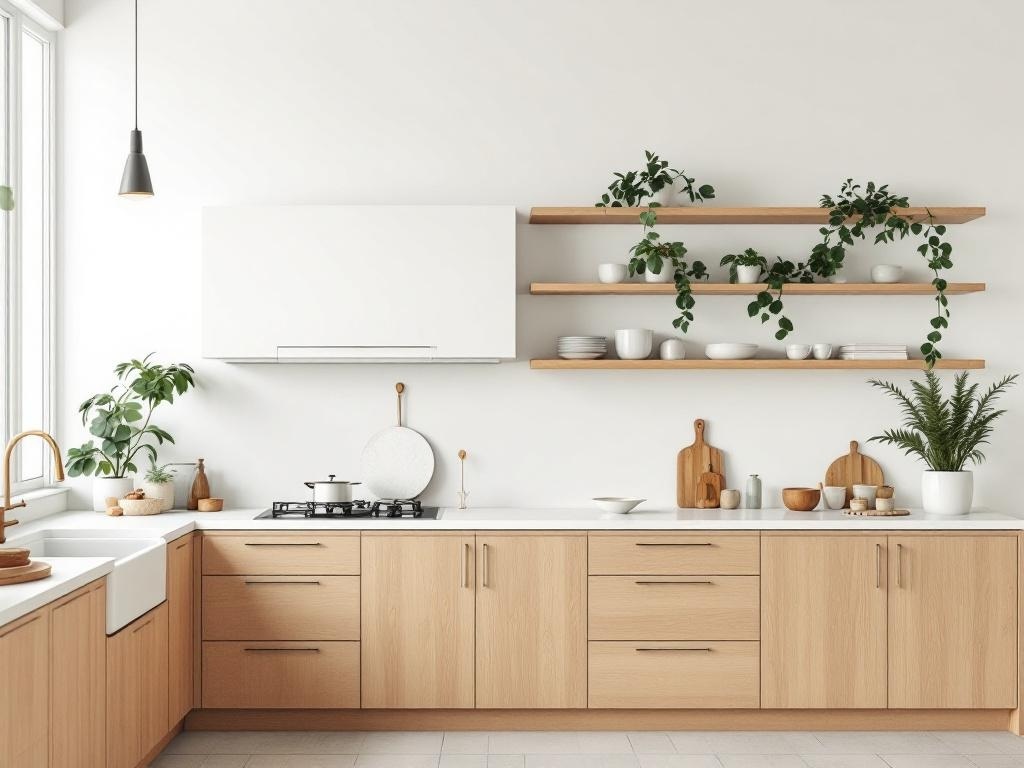
The Japandi aesthetic beautifully blends Japanese minimalism with Scandinavian functionality, and natural wood elements play a key role in this style. The kitchen in the image showcases warm wooden cabinetry that adds a cozy touch to the space. The light wood tones create a sense of calm and simplicity, making the kitchen feel inviting.
Open shelving made of wood is another highlight. It not only provides storage but also displays beautiful dishware and plants, enhancing the natural vibe. The greenery adds life and freshness, complementing the wood’s warmth. This combination creates a harmonious balance, perfect for a modern kitchen.
Natural wood elements are not just about looks; they also bring texture and warmth to the design. The smooth finishes of the cabinets and shelves contrast nicely with the sleek white countertops, creating an appealing visual dynamic. This kitchen is a great example of how wood can transform a space into a serene and functional environment.
Statement Lighting Fixtures
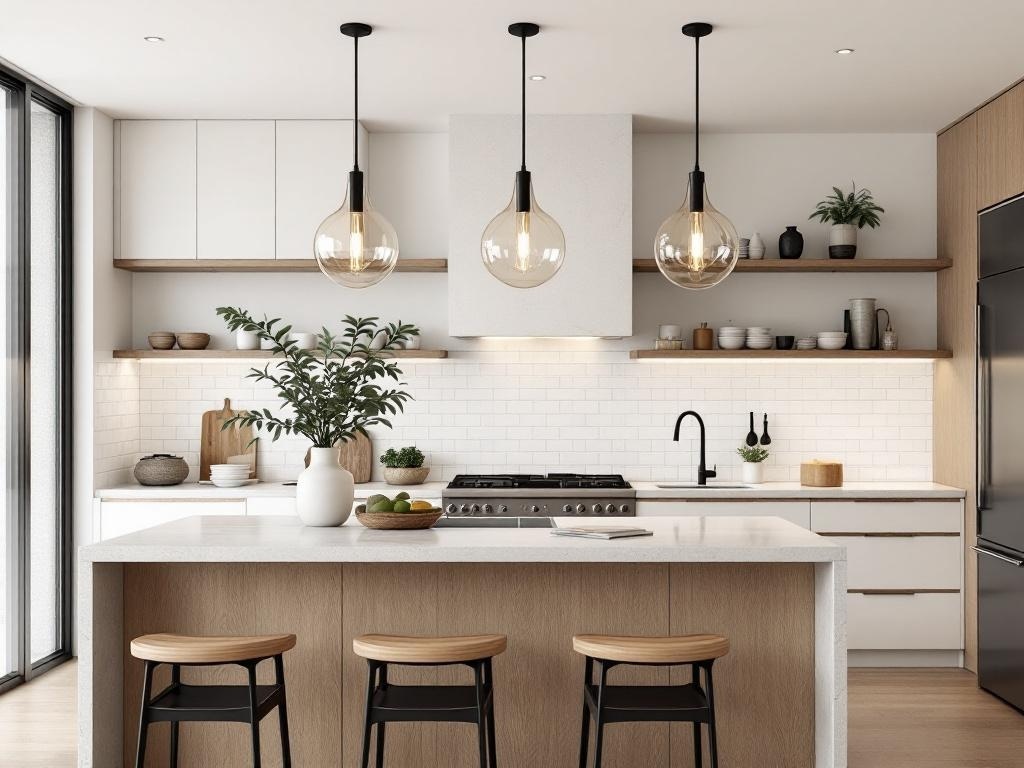
In a Japandi aesthetic kitchen, statement lighting fixtures play a key role in tying the design together. The image showcases three elegant pendant lights hanging above a sleek kitchen island. Their round shapes and warm glow create a welcoming vibe, perfect for both cooking and entertaining.
These fixtures not only illuminate the space but also add a touch of personality. The contrast between the black fixtures and the soft, natural tones of the wood and white cabinetry enhances the overall look. This balance is essential in Japandi design, where simplicity meets functionality.
Choosing the right lighting can transform your kitchen. Consider fixtures that complement your style while providing ample light. The right choice can make your kitchen feel cozy and inviting, encouraging family gatherings and culinary creativity.
Textured Surfaces
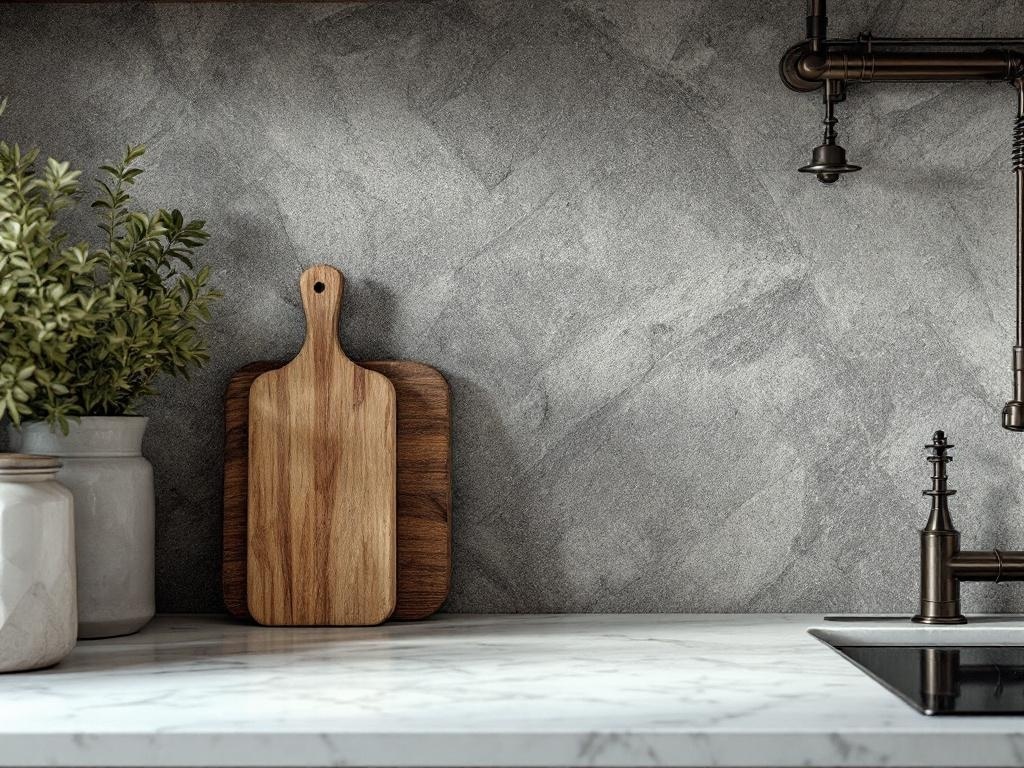
Textured surfaces play a key role in the Japandi aesthetic. This style combines Japanese minimalism with Scandinavian functionality, creating a warm and inviting space. The image showcases a beautiful kitchen corner that highlights this concept perfectly.
The backdrop features a stunning textured wall that adds depth and character. The subtle variations in the surface catch the light beautifully, enhancing the overall look. This kind of texture is essential in creating a cozy atmosphere while keeping things simple.
On the countertop, wooden cutting boards add a natural element. They contrast nicely with the sleek marble surface, showcasing the balance between organic and modern materials. A potted plant brings a touch of greenery, softening the hard surfaces and adding life to the space.
The dark faucet and fixtures introduce an industrial touch, complementing the textured wall. This mix of materials and finishes is a hallmark of the Japandi style, making the kitchen not just functional but also a visual delight.
Integrated Appliances

In a Japandi aesthetic kitchen, integrated appliances play a key role in creating a seamless look. The image showcases a sleek design where the appliances blend effortlessly into the cabinetry. This approach not only saves space but also maintains the clean lines that define the Japandi style.
The minimalist design of the cabinetry, paired with the dark accents of the appliances, enhances the overall aesthetic. You can see how the combination of light and dark elements creates a balanced feel, making the kitchen inviting yet sophisticated.
Integrated appliances also contribute to functionality. They are designed to fit perfectly within the kitchen layout, ensuring that everything you need is within reach. This thoughtful arrangement allows for a more organized cooking space, which is essential for any home chef.
Choosing appliances that match the cabinetry color can further elevate the design. This creates a cohesive look that is both modern and timeless. Whether you’re cooking a simple meal or entertaining guests, an integrated kitchen makes the experience enjoyable.
Cozy Nook Areas
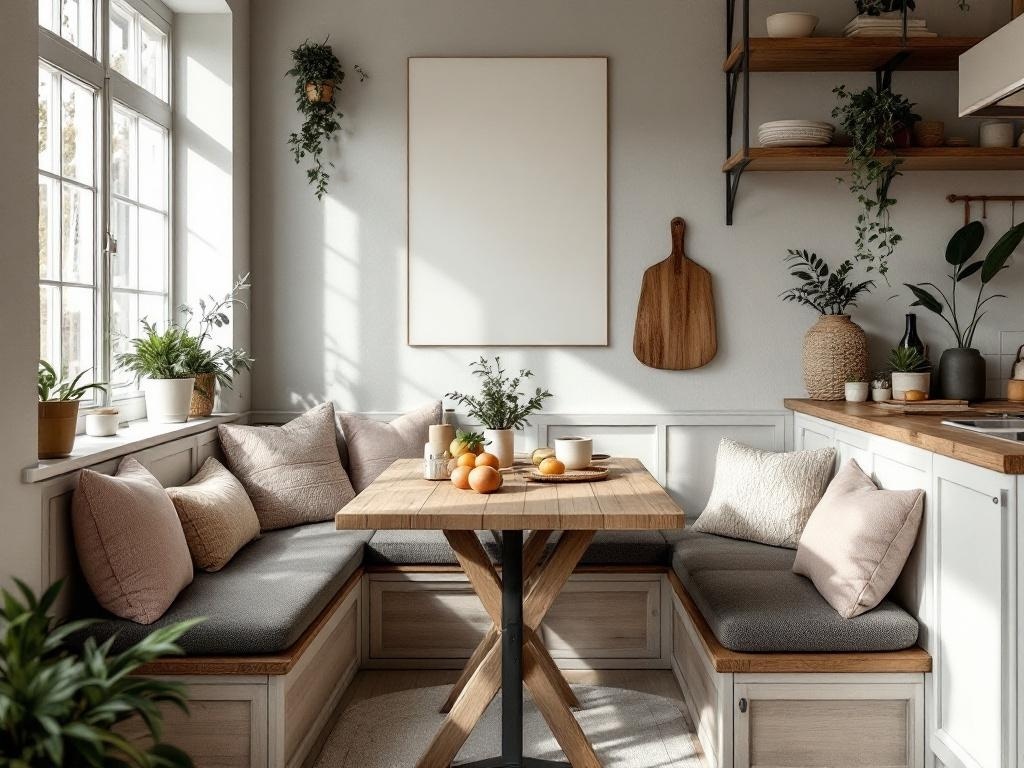
Creating a cozy nook in your kitchen can transform it into a warm and inviting space. This image showcases a charming corner with a built-in bench, perfect for enjoying meals or sipping coffee. The soft cushions and natural light streaming through the windows add to the comfort.
The Japandi aesthetic emphasizes simplicity and functionality. Here, the blend of wood and neutral tones creates a serene atmosphere. The plants bring a touch of nature indoors, enhancing the overall vibe.
Consider adding a small table for casual dining or a place to read. This nook not only serves as a dining area but also as a cozy retreat within your kitchen. It’s a great spot to unwind and enjoy the little moments of life.
Minimalist Design Approach

The Japandi aesthetic blends Japanese minimalism with Scandinavian functionality, creating a serene kitchen space. This image showcases a clean, uncluttered design that emphasizes simplicity and natural materials.
The light wood cabinetry pairs beautifully with the white countertops, offering a warm yet modern feel. Open shelving displays a few carefully chosen items, adding a personal touch without overwhelming the space.
Natural elements, like the greenery in a vase, bring life to the kitchen while maintaining a minimalist vibe. The overall look is inviting, making it a perfect spot for cooking and gathering.
Functional Open Spaces

The Japandi aesthetic blends Japanese minimalism with Scandinavian functionality, creating a kitchen that feels both serene and practical. This image showcases a spacious kitchen with clean lines and a neutral color palette, making it a perfect example of this style.
The open layout invites natural light, enhancing the feeling of space. Large windows allow for a bright atmosphere, while the simple cabinetry keeps the look uncluttered. The light wood tones and soft textures add warmth, making the kitchen feel welcoming.
The central island serves multiple purposes. It’s a place for meal prep, casual dining, and socializing. The choice of comfortable seating encourages family and friends to gather, turning cooking into a shared experience. Plants add a touch of nature, bringing life to the space.
This kitchen design emphasizes functionality without sacrificing style. Every element is thoughtfully placed, ensuring that the space is not only beautiful but also practical for everyday use. It’s a perfect example of how modern kitchens can be both stylish and functional.
Neutral Color Palette
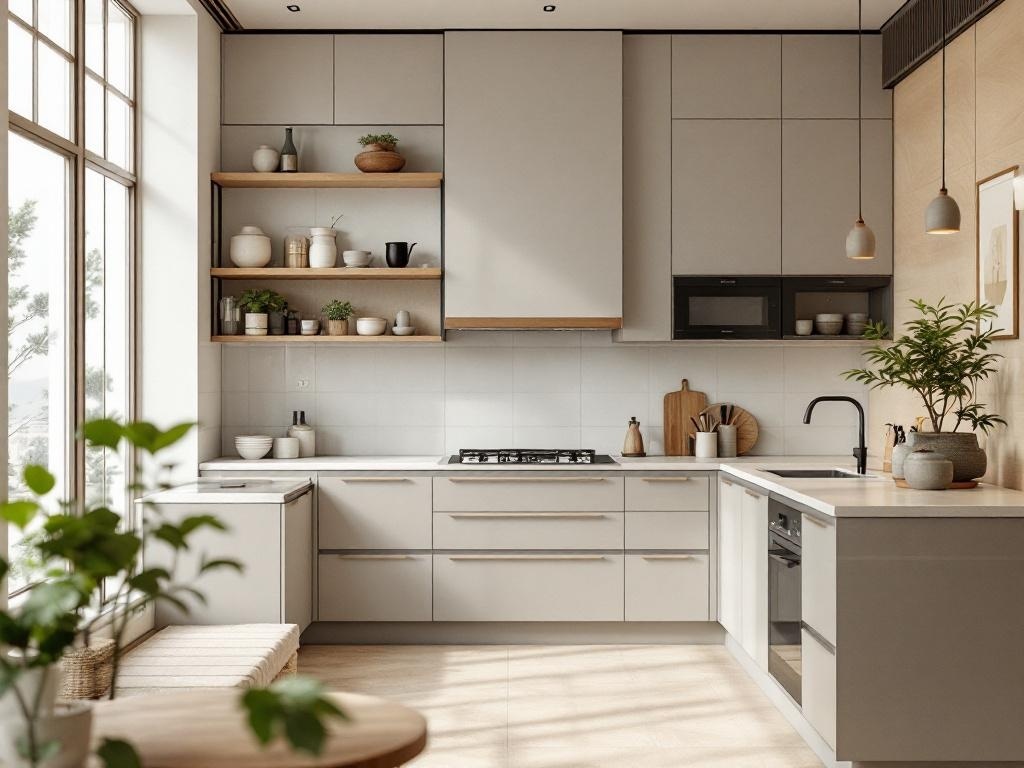
The Japandi aesthetic shines through in this modern kitchen, showcasing a neutral color palette that feels both calming and inviting. Soft grays and warm wood tones blend seamlessly, creating a space that is both functional and stylish.
Natural light pours in through large windows, enhancing the serene atmosphere. The combination of sleek cabinetry and open shelving offers a clean look while providing ample storage. Simple decorative items, like plants and ceramics, add a touch of personality without overwhelming the space.
This kitchen perfectly embodies the Japandi style, where minimalism meets warmth. The neutral colors not only make the kitchen feel spacious but also allow for easy customization with colorful accessories or seasonal decor.
Sustainable Materials

The kitchen in the image beautifully showcases the Japandi aesthetic, blending Japanese minimalism with Scandinavian functionality. The use of natural wood for the cabinetry and island emphasizes sustainability, a key element in modern kitchen designs.
Choosing sustainable materials not only benefits the environment but also creates a warm and inviting space. The light wood tones in the kitchen add a touch of nature, making the area feel more connected to the outdoors.
Incorporating eco-friendly materials like bamboo or reclaimed wood can enhance the overall look while reducing your carbon footprint. The clean lines and simple design reflect a commitment to quality and longevity, which is essential in a Japandi style kitchen remodel.
Using energy-efficient appliances and low-VOC finishes further supports a sustainable approach. This kitchen is a perfect example of how thoughtful design can create a stylish and eco-conscious space.
Smart Storage Solutions
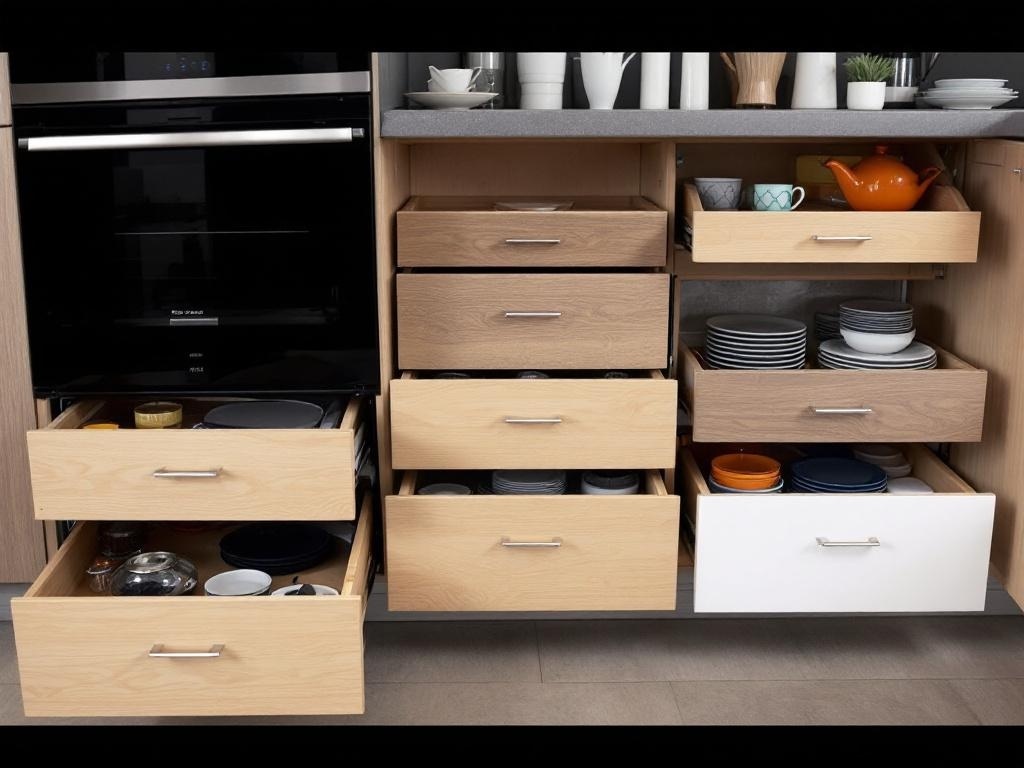
When it comes to a Japandi aesthetic kitchen, smart storage solutions are key. The image showcases a beautifully organized kitchen with a mix of drawers and open spaces. Each drawer is designed to hold various kitchen items, from plates to pots, making everything easily accessible.
The combination of light wood and sleek finishes adds a modern touch while keeping the space feeling warm and inviting. Notice how the drawers are arranged in a way that maximizes space without feeling cluttered. This is essential in a kitchen where functionality meets style.
Incorporating pull-out drawers allows for better visibility of your kitchenware. You can quickly grab what you need without digging through stacks of items. This design not only enhances usability but also complements the minimalist vibe of Japandi style.
Using different drawer sizes is another smart move. Larger drawers can hold bulkier items, while smaller ones are perfect for utensils and smaller kitchen gadgets. This thoughtful organization helps maintain a clean and tidy kitchen, making cooking a more enjoyable experience.
Open Shelving Displays
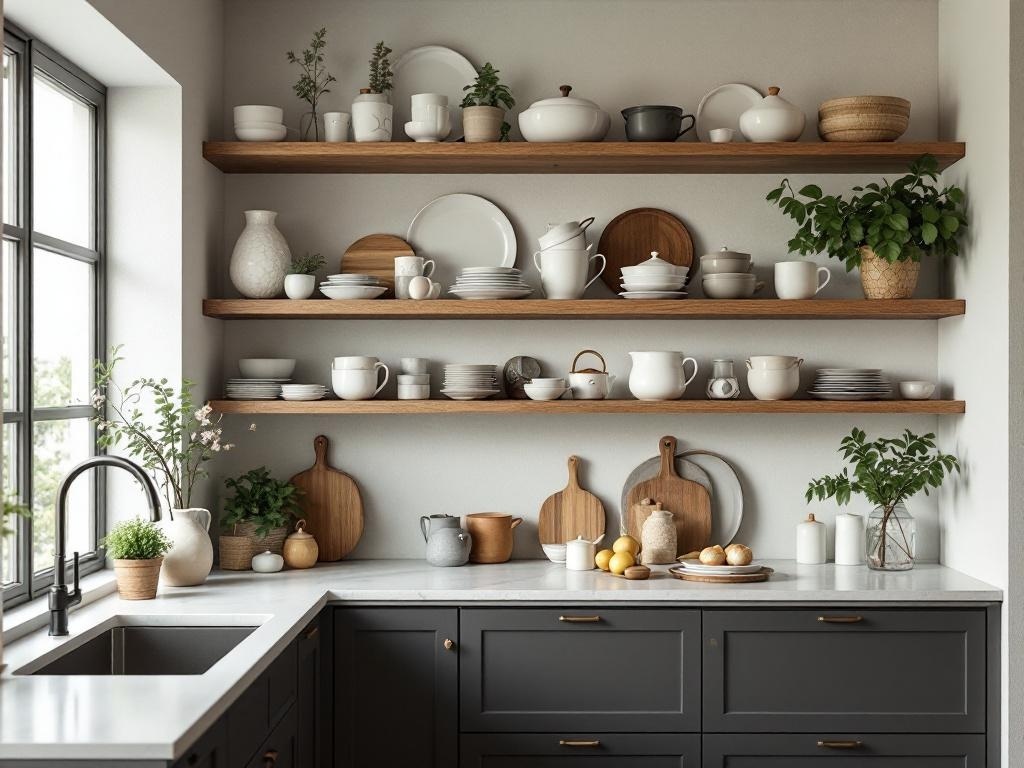
Open shelving is a key feature in Japandi-style kitchens, blending functionality with aesthetic appeal. The image showcases beautifully arranged shelves that highlight a mix of ceramics, wooden boards, and greenery. This setup not only serves as storage but also as a decorative element.
The choice of materials is crucial. The warm wood of the shelves contrasts nicely with the sleek, dark cabinetry below. This combination creates a cozy yet modern vibe, perfect for a kitchen remodel. The open shelves invite creativity, allowing you to display your favorite dishes and plants.
Incorporating plants adds a touch of nature, enhancing the overall feel of the space. Simple, clean lines and a neutral color palette keep the look fresh and uncluttered. This approach to open shelving encourages a minimalist lifestyle, making it easy to access everyday items while keeping the kitchen stylish.
Elegant Backsplash Choices

The backsplash in a kitchen plays a vital role in both style and function. In a Japandi aesthetic kitchen, the choice of backsplash can enhance the overall look while keeping things simple and clean. The image showcases a beautiful hexagonal tile backsplash in soft gray tones. This choice adds a modern touch without overwhelming the space.
Hexagonal tiles are not just trendy; they also create a sense of depth and texture. The light color complements the white cabinetry and marble countertop, making the kitchen feel bright and airy. This design choice aligns perfectly with the Japandi style, which emphasizes minimalism and natural elements.
Incorporating plants and wooden utensils, as seen in the image, brings warmth and a touch of nature into the kitchen. These elements balance the sleekness of the tiles and appliances, creating a harmonious environment. Choosing a backsplash that reflects your personal style while maintaining the principles of Japandi can truly transform your kitchen.
Warm Lighting Ambiance
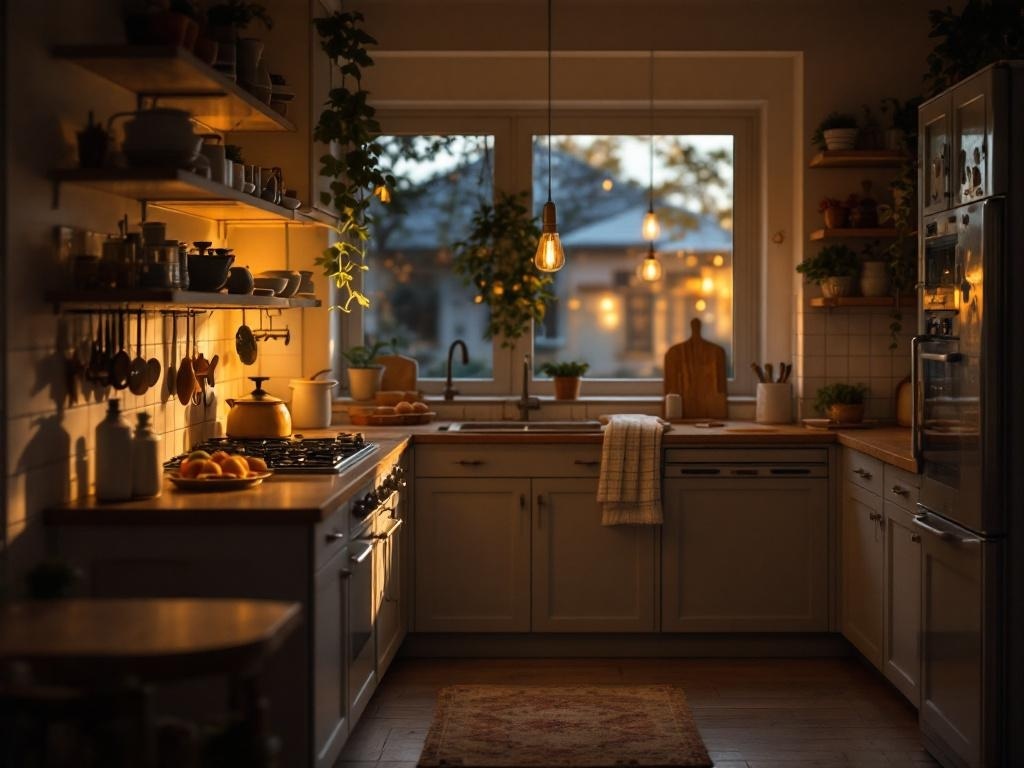
In a Japandi style kitchen, warm lighting plays a key role in creating a cozy atmosphere. The soft glow from pendant lights and under-shelf fixtures enhances the natural wood tones and muted colors typical of this aesthetic.
The image shows a kitchen bathed in golden light, highlighting the simplicity and functionality of the space. The warm hues invite you to relax and enjoy the surroundings, making it a perfect spot for cooking or gathering with friends.
Plants on the windowsill and shelves add a touch of life, complementing the warm lighting. This blend of nature and light creates a peaceful vibe, ideal for a modern kitchen.
Contrast of Textures
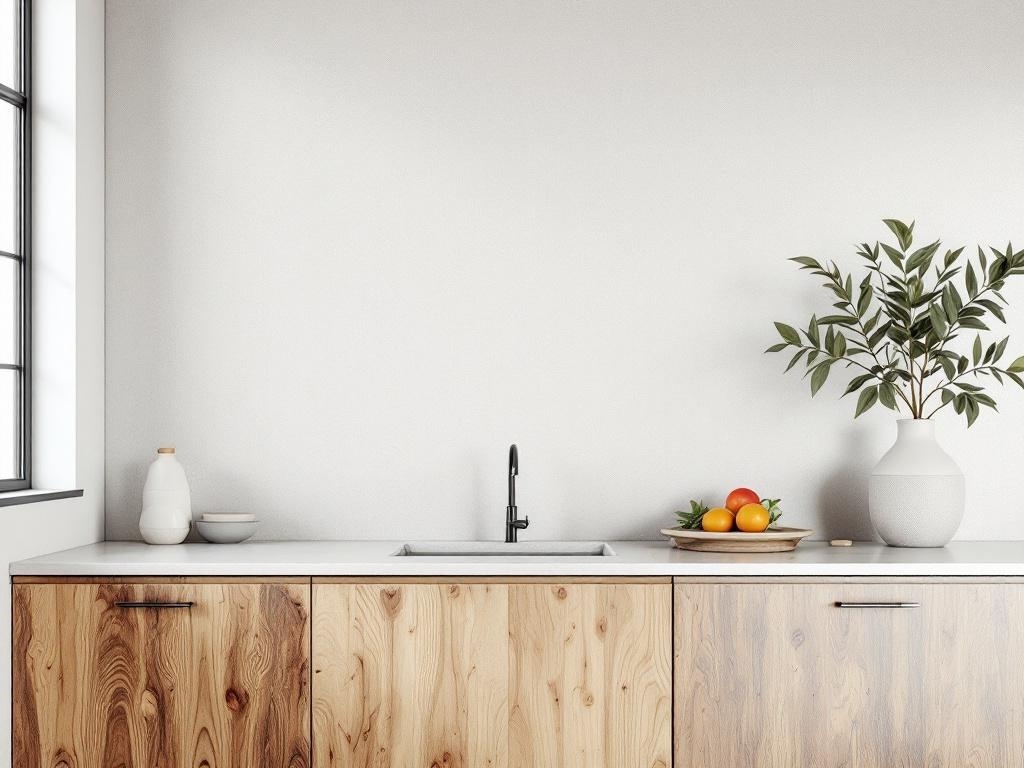
The image showcases a beautifully designed kitchen that embodies the Japandi aesthetic. The blend of natural wood and smooth surfaces creates a striking contrast. The cabinetry features a warm, textured wood grain, adding a cozy feel to the space.
The sleek countertop complements the wooden elements perfectly. This mix of textures not only enhances visual interest but also invites touch. The minimalist decor, including a simple vase and fresh fruits, adds a touch of life without overwhelming the design.
In Japandi style, balance is key. The smooth, clean lines of the sink and countertop contrast beautifully with the organic feel of the wood. This harmony makes the kitchen feel both modern and inviting, perfect for cooking or entertaining.
Indoor Plants for Freshness
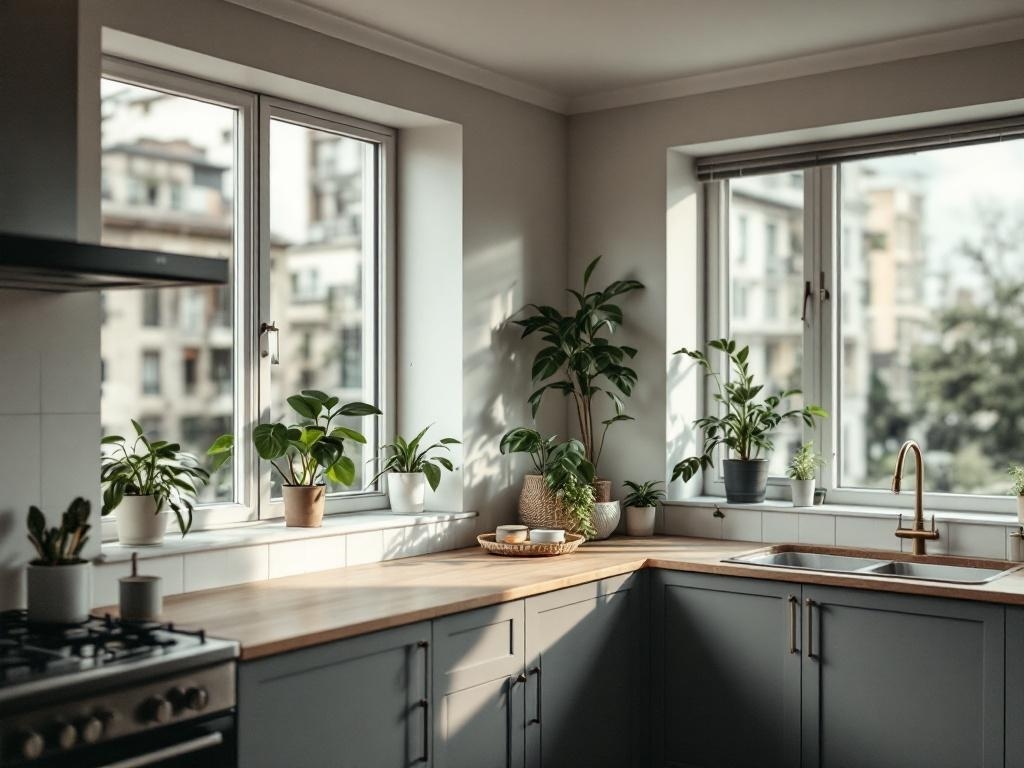
In a Japandi aesthetic kitchen, indoor plants bring a touch of nature indoors. The image showcases a bright kitchen filled with various plants that add life and color to the space. These plants not only enhance the visual appeal but also contribute to a fresh atmosphere.
Choosing the right plants can make a big difference. Low-maintenance options like snake plants or pothos are perfect for busy kitchens. They thrive in indirect light and require minimal care, making them ideal for those who want greenery without the fuss.
Positioning plants near windows, as shown in the image, allows them to soak up natural light. This not only helps the plants flourish but also brightens up the kitchen. The combination of greenery and natural light creates a serene environment, perfect for cooking and gathering.
Incorporating plants into your kitchen design can also improve air quality. Many indoor plants filter toxins and release oxygen, making your cooking space healthier. So, adding a few pots of greenery is a simple way to boost both aesthetics and well-being.
Japanese Influences in Design
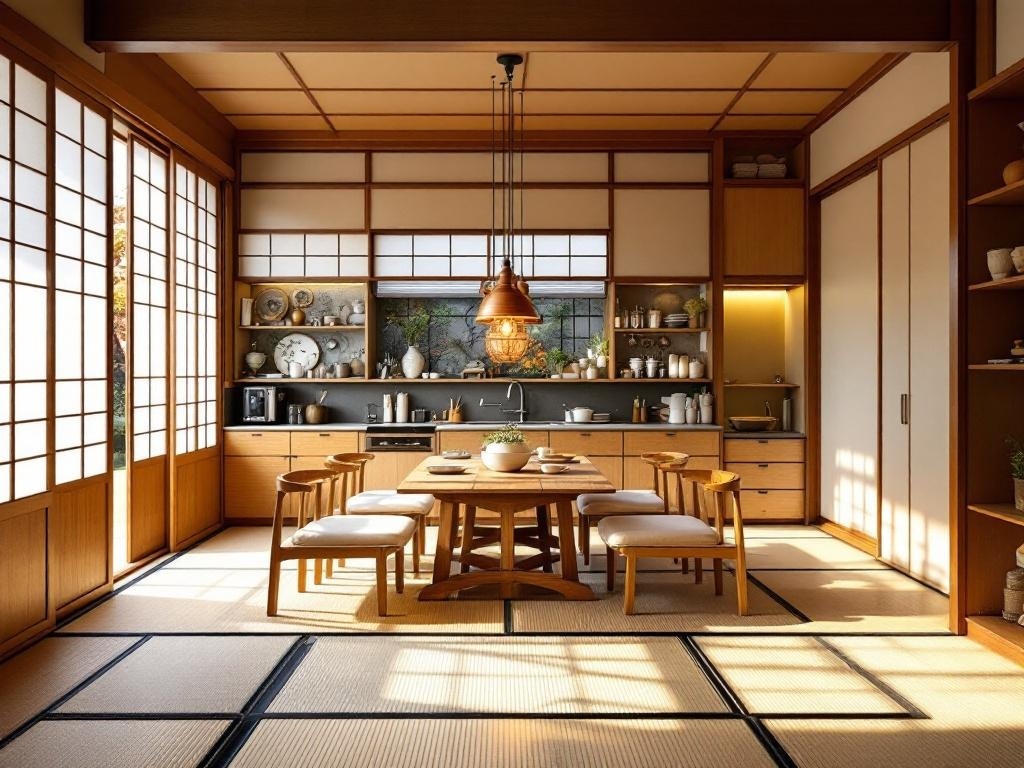
The image showcases a stunning kitchen that beautifully embodies the Japandi aesthetic. This style merges Japanese minimalism with Scandinavian functionality, creating a serene and inviting space.
Natural materials are key in this design. The warm wooden cabinetry and tatami flooring bring a sense of calm and connection to nature. The open shelving displays dishware in a way that feels both organized and artistic.
Light plays a significant role here. The large sliding doors allow sunlight to flood the room, enhancing the overall warmth. The pendant light above the dining table adds a modern touch while maintaining a cozy vibe.
Furniture choices reflect simplicity and comfort. The round dining table encourages gatherings, making it a perfect spot for family meals. The chairs are functional yet stylish, fitting seamlessly into the overall design.
This kitchen is not just a cooking space; it’s a reflection of a lifestyle that values simplicity, beauty, and functionality. It invites you to slow down and appreciate the little moments in life.
Artful Display of Cookware
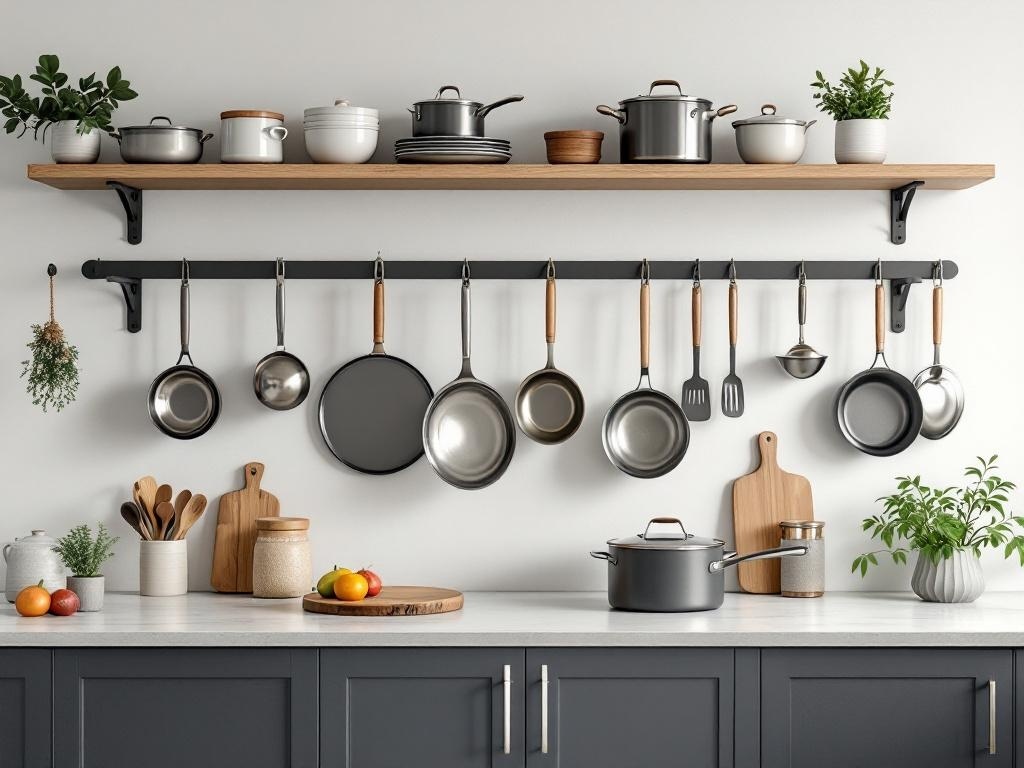
The image showcases a beautifully organized kitchen that embodies the Japandi aesthetic. The blend of Japanese minimalism and Scandinavian functionality creates a serene cooking space.
On the wooden shelf, various pots and containers are neatly arranged. The simple lines and muted colors reflect a calm vibe. The use of natural materials, like wood and ceramic, adds warmth to the kitchen.
Below, a metal rack holds an array of cookware, including frying pans and spatulas. This open display not only makes cooking convenient but also transforms everyday items into art. The hanging design keeps everything accessible while maintaining a tidy look.
Fresh herbs and small plants bring a touch of nature indoors, enhancing the overall aesthetic. The combination of greenery and cookware creates a lively yet organized atmosphere, perfect for any home chef.
Bold Accent Colors
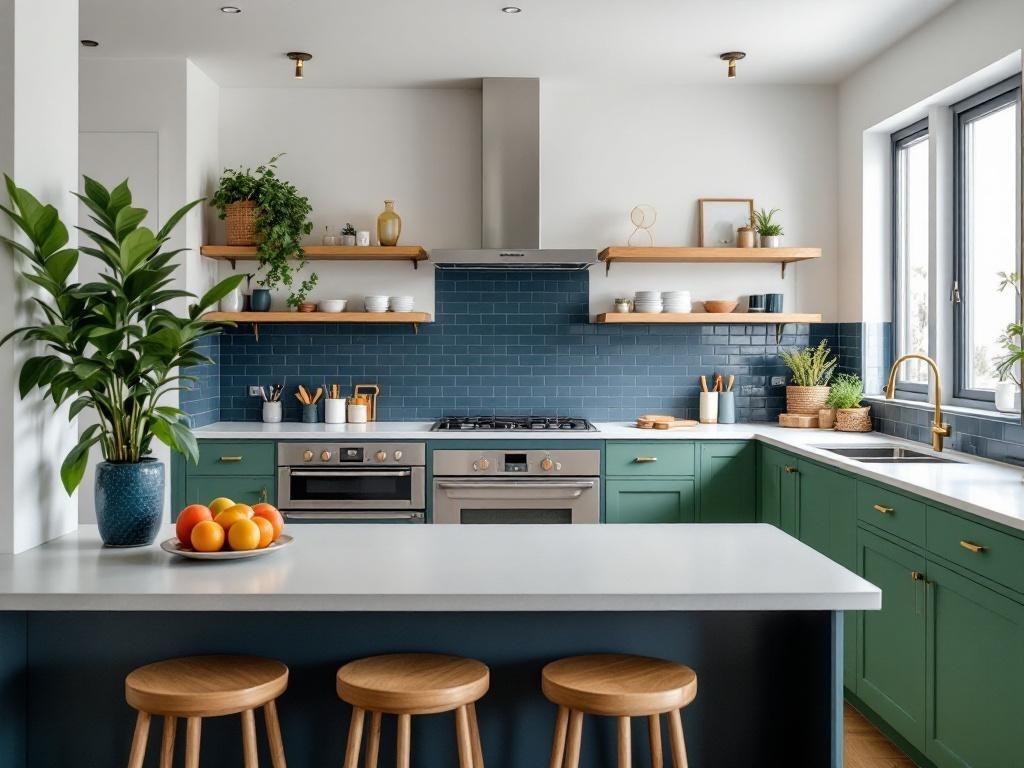
In a Japandi aesthetic kitchen, bold accent colors can really make a statement. This kitchen features a beautiful blend of deep green cabinetry and rich blue tiles. These colors add depth and character, creating a cozy yet modern vibe.
The use of natural materials, like the wooden stools and the plants, complements the bold colors perfectly. They bring warmth and a touch of nature into the space, which is essential in Japandi design.
Accent colors can be used in various ways, such as on cabinets, backsplashes, or even decor items. Here, the blue tiles act as a stunning backdrop, drawing the eye and enhancing the overall design.
Don’t shy away from experimenting with colors. A bold choice can transform your kitchen into a stylish and inviting area where you love to spend time.
Customized Kitchen Islands
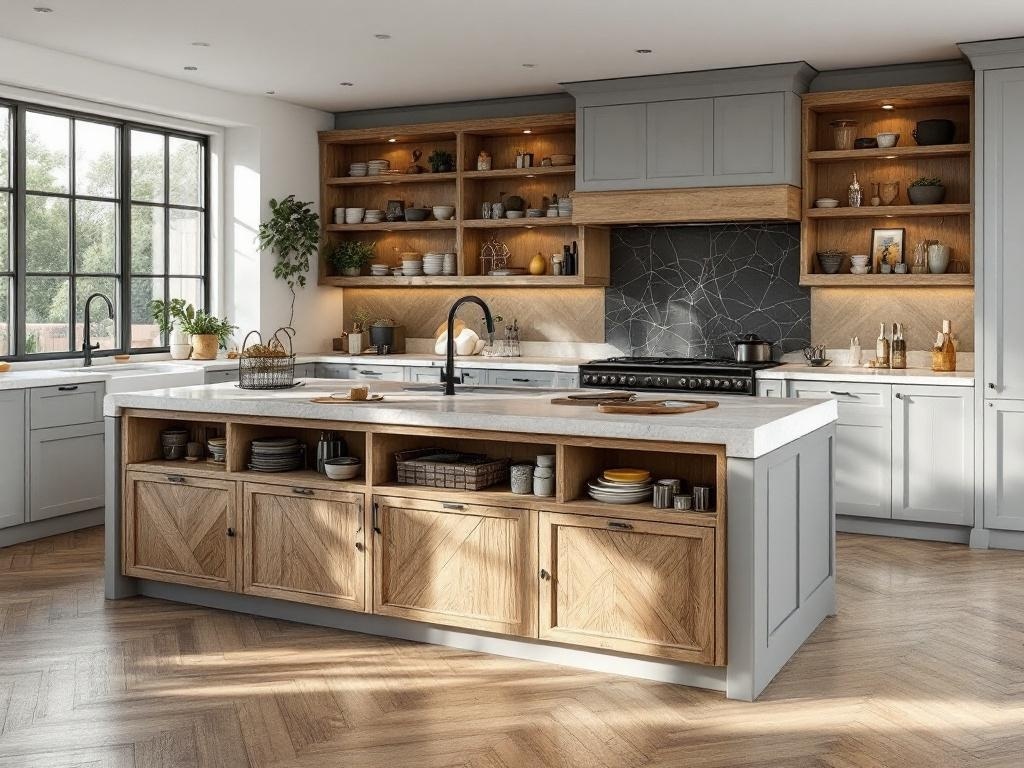
When thinking about a Japandi aesthetic kitchen remodel, customized kitchen islands play a key role. They blend functionality with style, making them the heart of the kitchen. The image showcases a stunning island that combines light wood with sleek, modern lines. This design not only looks great but also offers practical storage solutions.
The open shelving on the island is perfect for displaying beautiful dishware or plants, adding a touch of nature to the space. The contrasting materials, like the light wood and dark countertops, create a striking visual appeal. This balance is essential in Japandi design, where simplicity meets elegance.
Incorporating a customized island allows for personal touches. You can choose the size, shape, and materials that fit your needs. Whether you want extra seating or more storage, a tailored island can make your kitchen more functional and inviting. It’s a great way to bring your vision to life while enjoying the cozy, minimalist vibe of Japandi style.
Natural Light Maximization

In a Japandi aesthetic kitchen, natural light plays a key role in creating a warm and inviting space. The image showcases large windows that flood the room with sunlight, enhancing the natural materials used in the design.
The light wood cabinets and countertops reflect the sun’s rays, making the kitchen feel open and airy. This bright environment encourages a sense of calm and connection to nature, which is central to the Japandi style.
Plants are strategically placed near the windows, thriving in the abundant light. They add a touch of greenery, bringing life to the kitchen while improving air quality. The use of earthy tones and textures complements the natural light, creating a harmonious balance.
Choosing light colors for walls and furnishings can further amplify the effect of natural light. This approach not only makes the space feel larger but also highlights the beauty of the materials used, from the wooden shelves to the ceramic dishes.
Personal Touches in Decor

In a Japandi aesthetic kitchen, personal touches make all the difference. This image showcases a blend of natural elements and warm tones that create a cozy atmosphere. The wooden shelves are adorned with framed photos and decorative items, adding a personal flair to the space.
Plants play a key role in bringing life into the kitchen. The greenery on the shelves and window sill not only enhances the decor but also purifies the air. Simple, earthy pots complement the overall theme, making the kitchen feel inviting.
Every item in this kitchen tells a story. From the handmade pottery to the carefully chosen utensils, each piece reflects the homeowner’s personality. This thoughtful arrangement encourages a sense of warmth and comfort, making it a perfect spot for family gatherings.
Incorporating personal touches like family photos or cherished souvenirs can transform a kitchen into a space that feels uniquely yours. The Japandi style thrives on simplicity and functionality, allowing these personal elements to shine without overwhelming the design.
Cohesive Design Elements
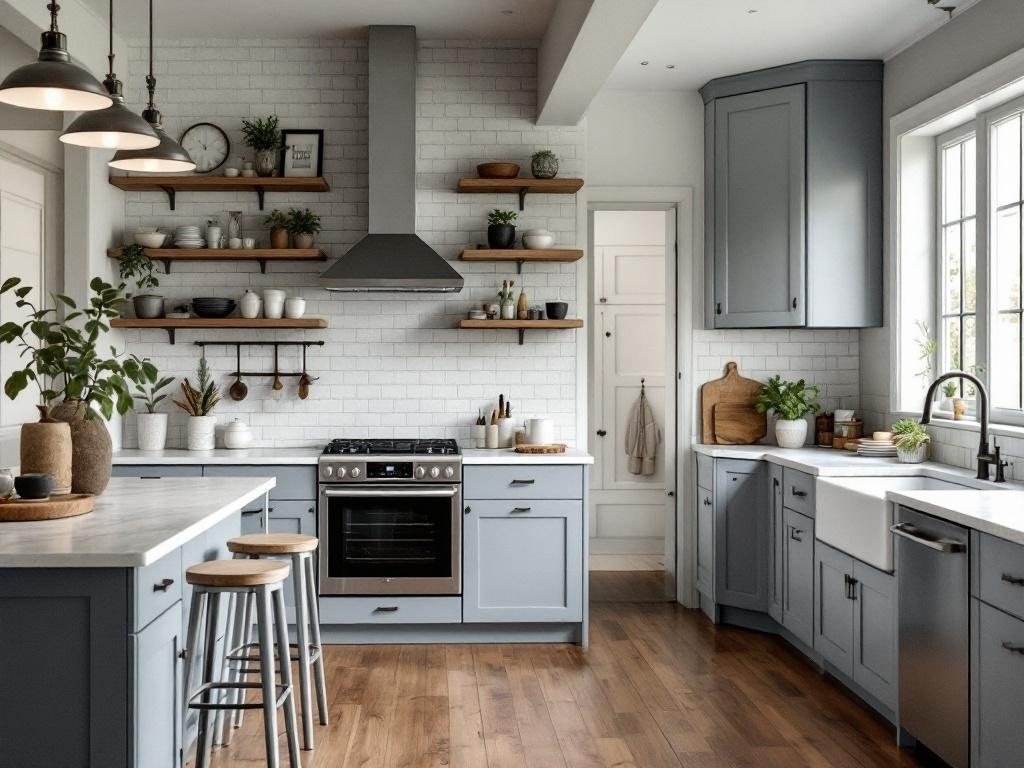
The Japandi aesthetic merges Japanese minimalism with Scandinavian functionality, creating a serene kitchen space. In this image, you can see how the soft gray cabinetry complements the warm wooden accents. The open shelving adds an airy feel, allowing for both storage and display.
Natural elements play a big role here. The plants on the shelves bring a touch of life, while the earthy textures of the pots enhance the overall vibe. The clean lines of the cabinetry and the sleek appliances keep the look modern yet inviting.
Lighting is another key element. The pendant lights above the island not only provide illumination but also serve as stylish focal points. This balance of form and function is what makes a Japandi kitchen so appealing.
Seamless Indoor-Outdoor Flow
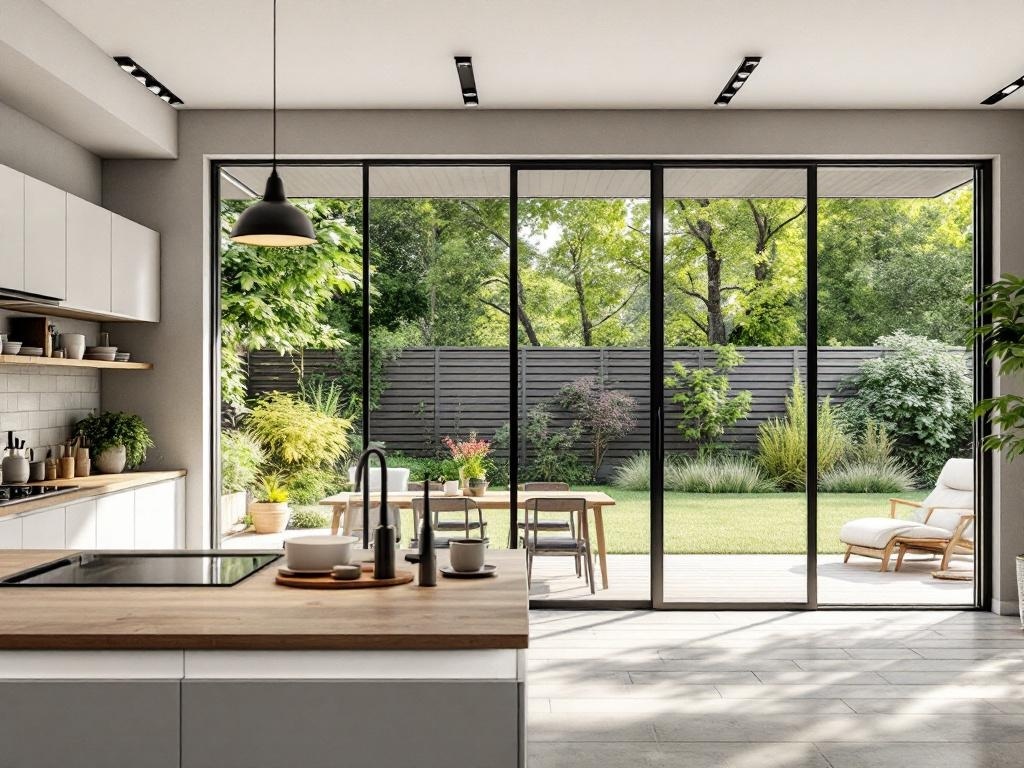
The image showcases a stunning kitchen that beautifully blends indoor and outdoor spaces. Large glass doors open up to a lush garden, creating a feeling of openness. This design invites nature right into the heart of the home.
The kitchen features clean lines and a minimalist aesthetic, typical of the Japandi style. The wooden countertop adds warmth, while the sleek cabinetry keeps things modern. The natural light pouring in enhances the inviting atmosphere.
With the outdoor seating area just a step away, this layout is perfect for entertaining or enjoying a quiet moment. The greenery outside complements the neutral tones inside, making the space feel connected and serene.
This seamless flow between the kitchen and garden not only enhances functionality but also elevates the overall living experience. It’s a perfect example of how Japandi style can harmonize with nature.